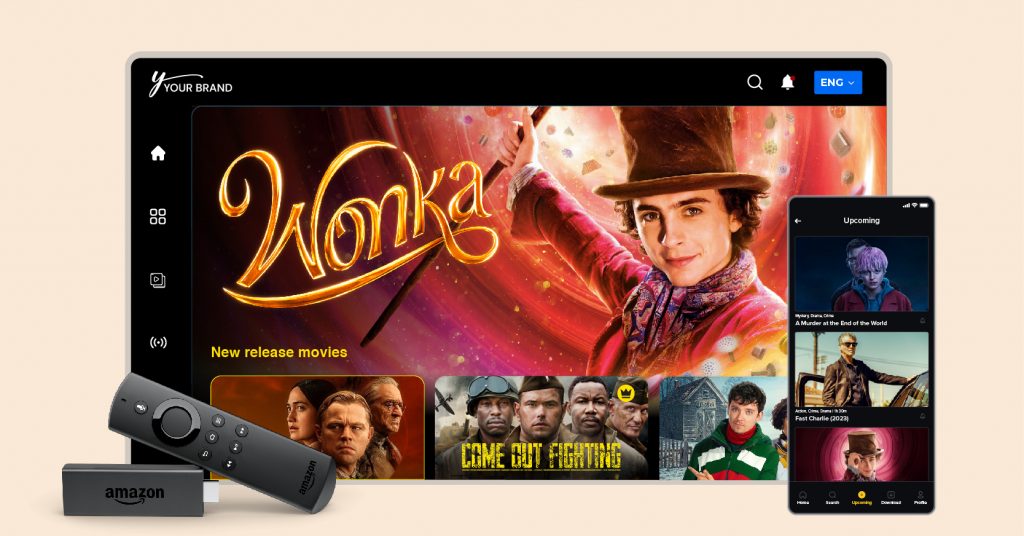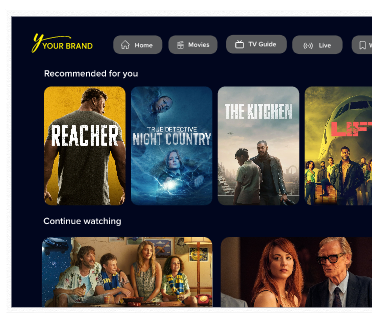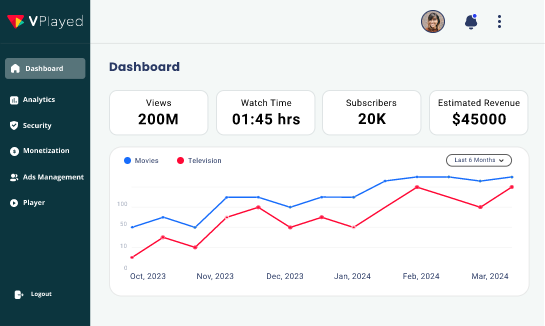Start and Grow Your OTT Streaming Platform With 1000+ Features & 10+ Revenue Models.
Request a Free DemoOTT vs IPTV: Which one is Better for Video Streaming?

When it comes to online streaming, the terms “IPTV” and “OTT” frequently emerge, often creating a conundrum for organizations seeking the ideal streaming solution.
While both play pivotal roles in the transition from traditional broadcasting to Internet-based streaming, they are actually distinct entities, each with its own set of characteristics of OTT vs IPTV.
Gone are the days of adhering to fixed TV schedules, as consumers seize the flexibility of on-demand content.
According to Techjury, the shift away from cable and satellite TV is anticipated to be significant, with a projected 26% drop in penetration by 2030.
As we navigate this transformative phase, understanding the differences between IPTV and OTT becomes utmost important.
The global OTT Video market is projected to reach a staggering US$295.40 billion by the end of 2023, with an estimated 7.30% annual growth rate leading to a market volume of US$420.10 billion by 2028 (Statista).
So, what sets these OTT and IPTV apart, and how can businesses choose the one that best aligns with their needs?
For that, join us on this blog to uncover the nuances of IPTV vs. OTT and make an informed decision for the future of your streaming endeavors.
Let’s get started!
- Fully Customizable
- Lifetime Ownership
- On-Premise/On-Cloud
- 100% White-label
- Zero Revenue Share
- Hire Developers
Table of Contents
What Is IPTV (Internet Protocol Television)?

In the modern entertainment era, IPTV, or Internet Protocol Television, has emerged as a revolutionary concept, transforming the way we consume television content.
At its core, IPTV utilizes the Internet Protocol (IP), signifying a television that operates seamlessly with the help of the Internet.
To start IPTV business on this digital TV journey, keep in mind that a fast broadband connection becomes imperative, paving the way for viewing on-demand video content and live TV programs.
Delivering Content via IP Networks
IPTV services, commonly disseminated by service providers, employ IP networks to transmit content, offering a personalized and versatile viewing experience.
This innovative approach caters to individuals of diverse ages, preferences, and geographical locations. The spectrum of IPTV capabilities is vast, aiming to meet the unique needs of a broad audience.
Affordability and Varied Subscription Models
A notable aspect of IPTV is its cost-effectiveness. In contrast to conventional cable subscriptions, IPTV services offer a range of subscription models, catering to a diverse audience.
From complimentary services to monthly subscription plans, IPTV’s flexible pricing structure appeals to budget-conscious consumers seeking high-quality content without extravagant costs.
Complexities from a Broadcaster’s Perspective
However, from a broadcaster’s standpoint, one can say that IPTV services all across the globe introduce a level of complexity.
Indeed, establishing a storage system for the countless number of videos available and crafting a user-friendly web interface are prerequisites.
Furthermore, the process involves encoding video files into suitable streaming formats and encrypting them with Digital Rights Management once a viewer selects a program.
Additionally, understanding the benefits of VPN and using this tool can enhance security by encrypting data and protecting user privacy, which is crucial in preventing unauthorized access and ensuring a safe streaming environment.
This intricate backend ensures a seamless and secure streaming experience for users, marking IPTV as a multifaceted and technologically sophisticated solution in the digital entertainment landscape.
How Does IPTV Work?
Now that we have explored what IPTV is, let’s look into the intricate workings that power this form of content delivery.
IPTV operates on a simple yet sophisticated principle, leveraging the capabilities of the Internet Protocol to transmit television content through IP networks.
On a basic note, IPTV functions in a way by delivering content in two primary ways: live television broadcasts and on-demand video streaming.
Live TV programs are streamed in real-time, mirroring the traditional broadcasting model but with the added flexibility.
On the other hand, the on-demand streaming feature of IPTV provides users with the privilege to decide when and what to watch.
Unlike conventional television that adheres to rigid schedules, IPTV empowers users to cherry-pick programs and shows.
This adaptability stands out as a pivotal factor fueling the widespread appeal of IPTV services and solutions.
IPTV’s Operational Overview
Now, let’s look at the working mechanism of IPTV – The process begins with the content being compressed and encoded into a suitable format for streaming.
Once prepared, the content is transmitted over IP networks, reaching users via their broadband connection.
Moreover, IPTV employs Internet Group Management Protocol (IGMP) to manage and control the delivery of multicast traffic.
This protocol facilitates efficient content distribution, ensuring that each viewer receives the content they requested without unnecessary data duplication.
All in all, IPTV’s operational framework combines technological sophistication with user-centric features, offering a versatile and personalized television experience.
As we continue our exploration of IPTV vs. OTT, let’s now get our eyes and brain to know more about OTT and its working mechanism. Let’s go!
What Is OTT (Over-The-Top)?

In a world where acronyms abound, what OTT is, emerges as the superhero of modern streaming. But fear not, there is no need for a cape – just a good Internet connection.
OTT delivers content directly to viewers via the Internet, bypassing traditional cable subscriptions. It’s like having your favorite show delivered to your doorstep without the intervention of a cable guy.
Now, let’s break it down further. OTT essentially means going above and beyond the traditional broadcast and cable providers, offering a more liberated viewing experience.
OTT platforms come in various forms, from OTT streaming services like Netflix to social media platforms hosting video content without the need for a satellite connection.
Unlike IPTV, which relies on dedicated IP networks, OTT makes the most out of the existing infrastructure.
This means you can enjoy your favorite movies, series, or whatever on any device with Internet access – This be it on your smart TV, desktop, laptop, tablet, or smartphone.
Looking To Build Your Own OTT Video Platform?
Start and Grow Your Video Streaming Service With 1000+ Features & 9+ Revenue Models.
 Highly Customizable
Highly Customizable Life Time Ownership
Life Time Ownership Own 100% of Your Revenue
Own 100% of Your Revenue Full-Branding Freedom
Full-Branding Freedom

How Does OTT Work?
OTT operates by delivering content directly to individual users over the Internet, allowing for a personalized viewing experience.
Leveraging pre-recorded content stored in CDNs, OTT adapts to Internet speed, responds to user-initiated requests, and operates on a one-to-one transmission model, offering an affordable and user-centric alternative to traditional broadcasting.
- One-to-One Transmission Method
Unlike IPTV, which relies on broadcast-style transmission, Over-The-Top (OTT) operates on a one-to-one transmission method.
This means that content is delivered directly to individual users over the Internet, allowing for a more personalized viewing experience.
- Pre-Recording and CDN Storage
OTT leverages the convenience of pre-recording content and storing it in Content Delivery Networks (CDNs).
This strategic approach ensures that the content is readily available and can be efficiently delivered to the end user upon his/her request.
- Internet Connection Speed Dependency
The performance of OTT is intricately tied to the speed of the Internet connection.
Faster connections translate to smoother streaming experiences, while slower connections may result in buffering issues.
However, top OTT platforms adapt to network performance, dynamically adjusting the video quality to prevent prolonged buffering interruptions.
- User-Initiated Content Delivery
Unlike traditional broadcasting, OTT operates on a user-initiated model.
The OTT platform responds to specific requests from customers, delivering content only when requested.
This on-demand approach aligns with the modern viewer’s desire for flexibility and control over their entertainment choices.
- Affordable and User-Centric
OTT is often considered more affordable than Internet Protocol Television (IPTV), as it utilizes existing Internet infrastructure.
The OTT model allows customers to stream one video to a single device at a time, promoting cost-effective and user-centric content delivery.
- ISP’s Role in OTT
When it comes to OTT, Internet Service Providers (ISPs) play a crucial role by providing the infrastructure through which OTT services stream content.
Unlike IPTV, where the service provider manages the entire content delivery process, OTT places the responsibility on ISPs for the smooth conveyance of data.
- All in all, as we dissect the inner workings of OTT, the contrasts with IPTV become clearer, guiding us towards a more informed decision.
🌟 Read Also: How to Start an Online TV Channel and Make Money 🌟
IPTV vs. OTT – Pros and Cons
As businesses and individuals traverse the continually evolving landscape of digital streaming, conducting a thorough analysis of the pros and cons of IPTV and OTT is essential for making a well-informed decision.
IPTV Pros:
Reliable Quality: IPTV distinguishes itself with broadcast-like quality, ensuring a consistent and reliable streaming experience.
The dedicated network infrastructure minimizes interruptions, offering viewers a seamless and high-quality journey through their favorite content.
Dedicated Network: With IPTV, the luxury of a dedicated network ensures minimal buffering issues and smoother content delivery.
This focused infrastructure allows for a robust and reliable transmission of live broadcasts and on-demand content, catering to the demands of the audience.
Interactive Features: IPTV goes beyond mere content delivery, offering interactive features like Video on Demand (VOD).
This empowers users to exercise control over their viewing schedules, enhancing the overall engagement and satisfaction of the viewing experience.
IPTV Cons:
Infrastructure Dependency: Despite its advantages, IPTV’s reliance on a specific infrastructure can be a limitation.
This dependency may restrict accessibility compared to the more versatile Over-The-Top (OTT) platforms, especially in regions with limited network infrastructure.
Higher Costs: While IPTV offers a premium streaming experience, the initial setup and ongoing maintenance costs can be a bit on the higher side.
This factor may be a significant consideration for organizations or individuals operating within certain budget constraints.
OTT Pros:
Versatility: One of OTT’s standout features lies in its versatility.
By leveraging existing infrastructure, OTT video platform ensures accessibility across various devices, from smart TVs and laptops to tablets and smartphones.
This adaptability allows users to enjoy their favorite content anytime.
Cost-Effective: No doubt, OTT is often celebrated for its cost-effectiveness.
By eliminating the need for extensive infrastructure and specialized equipment, it presents a more economical solution.
This makes OTT an attractive option for those seeking quality content without the higher upfront costs associated with IPTV.
On-Demand Freedom: OTT places a premium on on-demand content, liberating users from fixed schedules.
The freedom to choose what, when, and where to watch has become a hallmark of OTT platforms, catering to the modern viewer’s desire for personalized viewing experiences.
OTT Cons:
Internet Dependency: One of the disadvantages of OTT lies in its reliance on Internet speed.
While fast connections provide a buffer-free streaming experience, slower connections may lead to buffering issues, impacting the overall quality of the viewing experience.
Less Broadcast Quality: When it comes to the flexibility part, some OTT platforms may compromise on broadcast quality.
For users with lower bandwidth or those accustomed to the pristine quality of traditional broadcasting, this trade-off might be a notable consideration.
Difference Between IPTV Vs. OTT? What’s Suitable For Your Service?

As you look at the IPTV and OTT service, determining the most suitable streaming service for your needs involves a careful consideration of various factors.
Let’s break down the comparison in both tabular and detailed formats:
- Network Infrastructure:
| Criteria | IPTV | OTT |
| Description | Relies on a dedicated network infrastructure for content delivery. | Utilizes existing Internet infrastructure for content transmission. |
| Consideration | It is ideal for areas with robust network infrastructure. | Offers versatility, suitable for regions with diverse connectivity levels. |
- Quality of Service:
| Criteria | IPTV | OTT |
| Description | Provides broadcast-like quality with a dedicated network. | Quality may vary based on the Internet speed; it may compromise on broadcast quality. |
| Consideration | Ensures a reliable, high-quality streaming experience. | Quality may be affected by the user’s network connection. |
- Cost Implications:
| Criteria | IPTV | OTT |
| Description | Initial setup and maintenance costs may be the higher side. | Generally more cost-effective with minimal infrastructure requirements. |
| Consideration | It is ideal for those with a higher budget for premium streaming. | Attractive for budget-conscious users seeking quality content without substantial upfront costs. |
- Accessibility:
| Criteria | IPTV | OTT |
| Description | Relies on specific infrastructure; accessibility may be somewhat limited. | Provides versatility and is accessible across various devices and platforms. |
| Consideration | Suitable for regions with well-established network infrastructure. | Offers broader accessibility, especially in areas with diverse connectivity levels. |
- Flexibility and Interactivity:
| Criteria | IPTV | OTT |
| Description | Allows for interactive features like Video on Demand (VOD). | Emphasizes on-demand freedom and personalized viewing experiences. |
| Consideration | Ideal for users who appreciate interactive features. | Appeals to those who prioritize flexibility and the freedom to choose their content. |
In deciding between IPTV and OTT, the choice ultimately hinges on your specific needs, preferences, and budget constraints.
Whether you prioritize broadcast-like quality, extensive interactivity, or cost-effectiveness, understanding the nuances of each option will guide you toward the streaming service that aligns best with your service requirements.
Summing Up
No doubt, the exploration of IPTV vs OTT unveils a tapestry of choices, each with its unique strengths and considerations.
IPTV, with its dedicated network and broadcast-like quality, suits areas with robust infrastructure and viewers valuing interactive features.
On the flip side, OTT’s versatility and cost-effectiveness, thriving on existing Internet structures, provide a broader reach and appeal to those who are craving for on-demand flexibility.
As the curtain falls on our exploration, the decision between IPTV and OTT hinges on individual preferences, budget constraints, and regional connectivity.
While IPTV carves a niche for premium quality, OTT emerges as a democratic force, focusing on accessibility and adaptability.
Whether you are drawn to the reliability of IPTV’s broadcast-style delivery or enticed by the freedom of OTT’s on-demand content, the choice is all yours, guided by a nuanced understanding of online video streaming intricacies.
- Request Demo Book a Live, Personalized Demo
- Contact Sales Reach Out to Our OTT Experts
